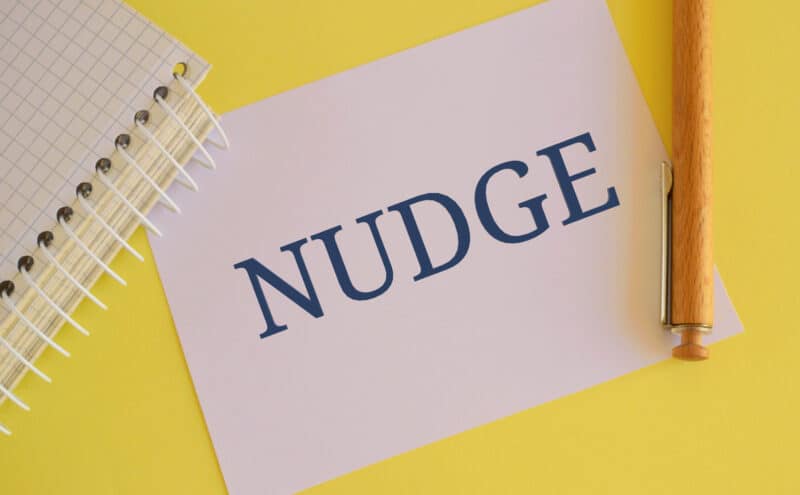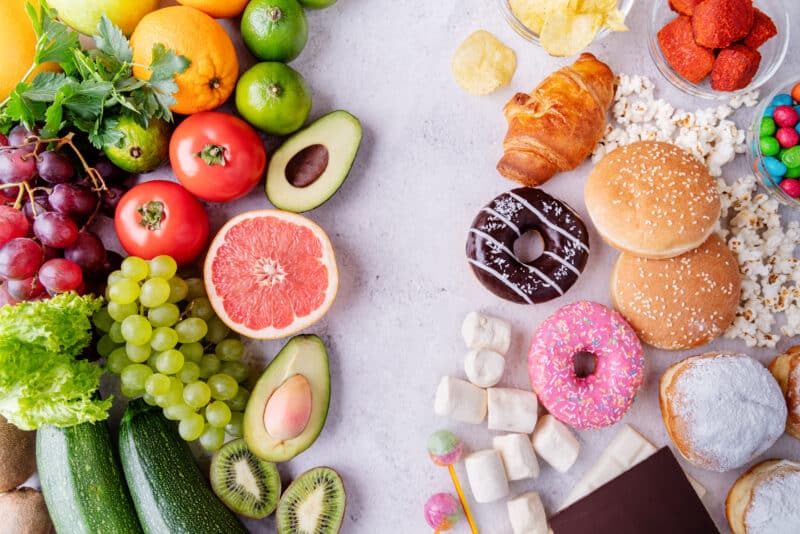FAT LOSS PSYCHOLOGY: NUDGE YOURSELF SLIM
FAT LOSS PSYCHOLOGY: NUDGE YOURSELF SLIM
Fat Loss Psychology – By Dr Pat Partington
(Click on the Reference Numbers in Blue for More Info)
In this article, I’m going to introduce you to a psychological influence that is powerfully shaping the behaviours of every single one of us, whether we like it or not. It is so influential that governments around the world are using it to manipulate our choices and decisions, mostly for the benefit of us but sometimes for them. It’s called nudge theory and I’m going to show how you can use this powerful psychological influence for your own health and wellbeing. In short then I’m going to show you how to nudge yourself slim.
Derived from behavioural economics, nudge theory can be summed up very simply by saying small changes can make a big difference and everything matters. But before we delve into the detail of how governments are manipulating our behaviours, and to hold your interest (you just want to lose weight, I know) here are a few nudge-related teasers to keep you keen.
- We are four times more likely to order dessert from an overweight waiter compared to a slim waiter, and we order 18% more alcoholic drinks from an overweight waiter (1).
- We eat more in larger groups. For example, dining with a group of 7 or more can increase the amount you eat by 96% (2) and you are also more likely to order dessert in a larger group (3).
- Men eat more when dining with a woman (as much as 92% more) and women eat less when dining with a man (depending on levels of familiarity of course) (4).
- We will help ourselves to twice as many snacks in an untidy kitchen compared to a tidy kitchen. And your snack choice will be less healthy if your kitchen is untidy (5, 6).
- You’ll help yourself to more alcohol (as much as 30% more) if you use a short wide glass compared to a tall thin glass (7). Even experienced bartenders will make this mistake.
- You’ll eat more from a large bowl than from a small bowl (sometimes 50% more). This is true even when the food is stale (8).
- Healthy food tastes better, and unhealthy food is less palatable when we eat in front of a mirror (9).
As you can see, a nudge is a psychological influence that occurs below the level of conscious awareness that directly influences our behaviour. The examples above can be considered as naturally occurring nudges but, as we’ll now see, nudge theory has been used in all manner of ways by organisations that want to purposefully shape our decisions and actions.

FAT LOSS PSYCHOLOGY: Is it ever OK to smack?
Encouraging populations to make decisions that will benefit society as a whole has been a challenge since time began. Well maybe not that long ago, but we’ve all seen Robin Hood and we know how the peasants of Ye Olde England were forced to part with their hard-earned groats to pay for King John’s wars and for the Sheriff of Nottingham to waste £37 billion on a failed test and trace system. Stay with me.
When it comes to changing behaviours at the population level there are four approaches that could be taken: the smack, shove, nudge or hug.
A smack is a punishment or a ban that usually has a penalty attached. Banning food with exceptionally high sugar or fat content would be a smack. The smoking ban was a smack and you are smacked when you are fined for speeding.
A shove is less deliberate and obvious than a smack. Increasing the minimum price of alcohol, for example, has the purpose of shoving choice in one direction. Charging high business rates to fast food shops near schools is another.
A nudge is a subtle influence occurring at the level below conscious awareness. Putting sweets at eye level in the shop and at the checkout are obvious examples of nudging. Moving items around in the supermarket so we discover different goods while searching for our favourite is another nudge. Every time you smell freshly baked bread halfway through your shopping journey you are being nudged.
We are hugged when we are rewarded for doing something. Shops can hug us by giving us free tokens for future purchases when we spend more than say £10 in their shop. This increases the likelihood that we will continue to spend money in these shops, after all, we all like being hugged don’t we?
The Sheriff of Nottingham’s taxation tactic was to use the ‘smack’ of course, an approach that’s still used today in various forms, but the times are changing. For example, in 2017 the UK Government encouraged those with tax arrears to pay up by sending letters stating, “Nine out of ten people with a debt like yours, in your area, pay their tax on time. You are in the minority that does not pay its tax on time.” This peer-pressure message helped bring in more than £12m over the year it was trialled. Welcome to the world of nudge. If only the sheriff had known, he could have saved himself an awful lot of aggro from Robin Hood.

FAT LOSS PSYCHOLOGY: The emergence of Nudge
The Nobel Prize-winning economist Richard Thaler and his colleague, academic lawyer Cass Sunstein, are famous for developing nudge theory (10). Never heard of them? OK, it’s a bit of a niche market, but I can assure you that you have been influenced in some way by the psychological effects they propose.
The influence is so powerful that government ‘nudge units’ have been established globally. For example, David Cameron set up the Behavioural Insights Team in 2010 with the aim of “enabling people to make better choices for themselves” (11). This sounds slightly sinister, it has to be said, but these choices are mostly related to environmental issues, influencing better health choices and improving quality of life.
For example, jobseekers got back to work more quickly when advisers stopped asking “What did you do last week to find a job?” (an approach they had been using for 30 years) and started asking “How will you use your time this week to find a job?” (12) Jobcentres observed a 20% improvement in employment prospects simply by encouraging people to proactively think ahead rather than reactively think back, something known as the question-behaviour effect (13). This small change made a big difference and here are a few more examples.

FAT LOSS PSYCHOLOGY: Antisocial behaviour
During the 2011 riots in southeast London, many shopfront shutters were ripped down and their windows smashed. Local authorities, of course, were faced with the challenge of how to combat this antisocial behaviour, which was financially as well as socially devastating to communities. Typically authoritarian ‘smack’ responses would involve an increased police presence, bigger fines and longer prison sentences to teach these people a lesson that this simply won’t be tolerated. Good on them we say, right?
However, leaders of the Borough of Greenwich had a different idea (14). They hired artists to paint images of local babies on their shop-front shutters and the results were shockingly effective. Social cohesion improved and antisocial behaviour was reduced by a quarter. No surprise that other local authorities quickly followed suit.
The sight of small babies, particularly from their own community, appeared to have ‘nudged’ a primeval protective mechanism outside of conscious awareness that, on the whole, effectively changed their behaviour.
Overuse of antibiotics
In 2016, the growth of antimicrobial resistance led the UK Government to send letters to 800 doctors stating: “80 per cent of practices in your local area prescribe fewer antibiotics per head than yours,” offering three alternatives to antibiotic prescriptions instead. This trial (15) led to 73,406 fewer antibiotic prescriptions, another nudge toward peer pressure and social norms.

FAT LOSS PSYCHOLOGY: Our aim is to keep these toilets clean…
We’ve all seen these signs haven’t we, yes “…your aim helps”, but the fact is that keeping toilets clean is a costly business. So what do you do if you are responsible for the bill? Put up signs politely reminding people of their responsibility to contribute toward lavatorial cleanliness? After all, it’s in everyone’s interest, isn’t it? A more direct approach would have your sign instruct people to “Keep these toilets clean!” Yes, we could take this kind of directive approach but those who pay the bills at Amsterdam’s Schiphol Airport tried a more subtle approach with surprising results (16).
In keeping with the notion that small changes can have a big impact, they arranged to have a picture of a fly etched into each urinal, and their cleaning bill is said to have fallen by 80%. Yes, the direction of the users’ pee was nudged toward the fly, thus avoiding the aimless spillage that men are notoriously renowned for. I think everyone’s a winner on that one. By the way, goalkeepers who wear bright colours are nudging strikers to shoot at them in just the same way (17).
FAT LOSS PSYCHOLOGY: Choice architecture
In their book Nudge: Improving decisions about health, wealth and happiness (10) Thaler and Sunstein describe the way that children’s food choices could be manipulated by the various ways that food is displayed in their school cafeterias. So some schools might display desserts first while other schools would display them last. Some schools would display carrot sticks at eye level while others would use this level to display chips. In short, the location of similar items was strategically varied between school cafeterias.
This type of nudging can reliably increase or decrease the consumption of different foods by as much as 25%. The process has come to be known as choice architecture and it is now well accepted as a powerful influencer of consumer behaviour. But with great power comes great responsibility because while schools will use choice architecture to maximise health, others will always use it to maximise profit. However, the key point I’m making here is that you can become your own choice architect to maximise your own health and wellbeing. Oh yes, and your weight.

FAT LOSS PSYCHOLOGY: Nudge yourself slim
A choice architect, then, has the responsibility for organising the context in which people make decisions and now you are going to take this responsibility for yourself. Yes, you are going to design and structure your own environment in ways that make it easier for you to make the right choices and to reach your long-term goals.
The two things to remember when designing your environment are first, small changes can make a big difference and secondly, everything matters.
- Weight loss starts at the shops. Minimise the influence of nefarious consumer choice architects by making sure you have a food list, preferable one that was made when you were not tired or hungry. When you are tired you enter a state of ego depletion (18) whereby your logical brain switches off and your emotional brain switches on. Your emotional brain wants you to eat!
- Downsize your plates and bowls. More specifically, halving your plate size can reduce the amount you eat by 30% and doubling it might have you eat a whopping 41% more (19). You can use this to your advantage, of course, so when you are serving salad get the bigger plates out.
The thing is, we don’t simply stop eating once we are full, I think everyone knows that by now. Our decisions about when to stop eating are informed by something called ‘consumption norms’ (20). Long story short, your brain monitors your plate’s appearance and when it looks empty your brain tells you, “Yes that’s probably enough now”. On the other hand, if your plate still looks like it has plenty to give, your brain will just instruct you to keep on eating.
Very soon you will get used to serving smaller portions sizes that appear more in keeping with your smaller plates. Interestingly, portion sizes increased by around 50% over the two decades that straddled the millennium (21) while the average prevalence of “severe obesity” doubled in the same period (22).
By the way, smaller plates usually don’t work in “all you can eat” buffets because we most often have a different mindset when we enter these establishments!
- Tidy your kitchen and your dining room. We’ve already seen that we eat more snacks in an untidy kitchen and your snack choices are less healthy (5,6), but how does this work? Well, research (23) has shown that clutter can have a direct impact on our mental health, increasing our cortisol levels and, in turn, our anxiety and stress. What do we do when we are stressed? Yes, we eat.
What’s more, cleaning has been shown to have many benefits to our mental health and the fact is that good mental health leads to better decision making (24). Another bonus is that clean rooms smell nice and research (25) has shown a strong link between smell and mood.
- Think about how your kitchen is arranged. We eat foods more readily when they are within close reach compared to farther away (26) so store unhealthy snacks in an inconvenient place out of sight. In contrast, make healthy foods more accessible, such as by placing a bowl of fresh fruit within easy reach on the kitchen worktop.
The food you see most clearly is more likely to become the food you eat (27) so put your sweets and biscuits in an opaque container and your healthier choices in clear containers.
Get a nice big mirror in your kitchen and face it during meal times – it’ll make your healthy food taste even better (9).

- Eat mindfully for weight loss (28). I’m going to introduce you to an exercise that I think you’ll enjoy; it’s called the chocolate meditation. You can substitute it for a cake meditation if you want to but whatever ‘treat’ you choose don’t use too much of it. You won’t need to if you do this properly anyway.
First take your chocolate, any type you like but this will be better if you choose one that you haven’t had for a while. In mindfulness meditation, there’s something referred to as a “beginner’s mind”, which means that you apply your mind to this chocolate as if you have never come across it before. You’ve never seen it, felt it, smelled it or tasted it before and everything is going to be completely new to you.
With an attitude of curiosity and interest, then, look at the chocolate. Look at it from different angles, see how the light shines on it, notice the colour and the different shades you can make out. Imagine how it would feel if you were to touch it, how the texture would feel on your fingers or how it might feel on your tongue.
Now smell the chocolate and just be aware of what you notice. Remember, this is the first time you have ever smelled chocolate so do it slowly. Perhaps you can notice what’s happening in your mouth as you do this: you might be licking your lips or your mouth might be watering at this point.
Now bring the chocolate toward your mouth and bite into it. Be aware of the taste and notice what’s happening in your mouth. Notice the texture of the chocolate as your tongue moves over it, as you chew it and move it around in your mouth. You might be aware that there are different tastes in different parts of your mouth. Once you have eaten the chocolate be aware of how your mouth feels now.
Did you notice anything about chocolate that you hadn’t before? Did you notice that you were distracted at any time during the exercise, perhaps by the urge to eat quickly? This often happens but when it does simply accept that this is just a thought and allow the thought to leave your mind as you gently bring your attention back to the chocolate.
This exercise can be done with any type of food and it will be worth trying it with an apple, which is going to bring some sound into the experience, or an orange, which might bring some more zing to your taste buds.
Eating with mindfulness is much more than simply eating slowly. Eating slowly is, of course, good practice for all sorts of reasons but eating with mindfulness is particularly important because it brings with it an awareness of the relationship between you and your food. Kabat-Zinn has said: “Mindfulness means paying attention in a particular way: on purpose, in the present moment, and non-judgementally” (29). The purpose isn’t necessarily to get you to enjoy food more but, rather, to experience food in a different way. Without trying to sound overly dramatic it brings to your attention your food-related inner wisdom. That means if you are an emotional eater you break the association, and it also breaks you out of the ‘mindless’ food decisions (30) that lead to overeating.

FAT LOSS PSYCHOLOGY
Conclusion
The world’s biggest organisations, shops and brands spend fortunes on behavioural psychology for a good reason. It works. Yes, it gets us to shop more, spend more and eat more, but you are now your own choice architect and you know how to unlock the power of behavioural psychology for the benefit of your own health. This means you are living your life in line with the proposition that small changes can make a big difference and everything matters.
When you put these five nudges into practice you’ll quickly train your brain to work differently regarding your food choices, eating behaviours and weight loss. All that’s needed is a little planning and a little effort on your part, but once you have your environment under control you’ll be amazed at how much easier it is to make healthy choices your new default setting. So what are you waiting for? Go nudge yourself slim!
If you have enjoyed “FAT LOSS PSYCHOLOGY: Nudge Yourself Slim” please check out these other articles from Dr Pat.
